The Toy Kitchens and Play Food Market is estimated to be valued at USD 3,468.7 million in 2025 and is projected to reach USD 4,661.6 million by 2035, registering a compound annual growth rate (CAGR) of 3.0% over the forecast period.
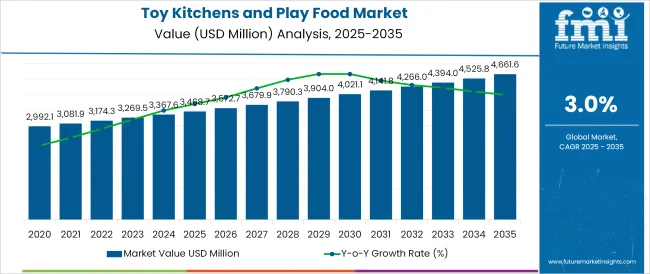
The toy kitchens and play food market is experiencing strong demand growth, driven by rising parental focus on imaginative play and the development of social and motor skills in children. Industry reports and product announcements have highlighted increased consumer spending on educational and interactive toys that promote real life role playing experiences.
Manufacturers have introduced diverse product lines emphasizing safety, realism, and eco friendly materials, catering to evolving consumer preferences. Seasonal sales spikes during festive periods and birthdays have further supported market expansion, alongside the rising popularity of gender neutral toys that encourage shared play. Retail partnerships and in store promotions have widened product accessibility, while the shift toward digital platforms has broadened the consumer base.
The market outlook remains positive as companies continue to innovate in design, incorporating interactive features and modular designs to sustain children's interest. Segmental growth is being led by Large Play Kitchens and Hypermarkets/Supermarkets as the preferred distribution channel, reflecting consumer interest in comprehensive playsets and the convenience of one stop retail shopping.
The market is segmented by Size and Distribution Channels and region. By Size, the market is divided into Large Play Kitchens, Corner Play Kitchen, and Toddler Play Kitchens. In terms of Distribution Channels, the market is classified into Hypermarkets/ Supermarkets, Direct Sales, Specialty Stores, Online retailing, and Others.
Regionally, the market is classified into North America, Latin America, Western Europe, Eastern Europe, Balkan & Baltic Countries, Russia & Belarus, Central Asia, East Asia, South Asia & Pacific, and the Middle East & Africa.
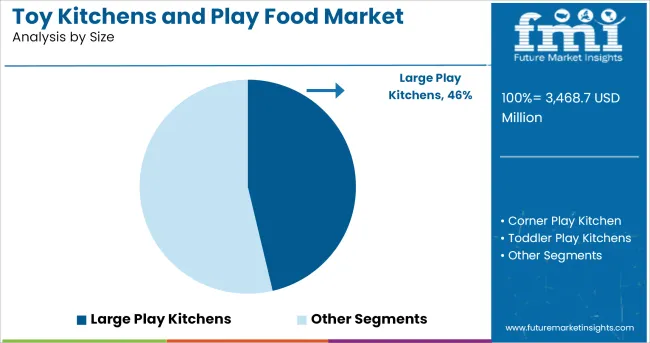
The Large Play Kitchens segment is projected to hold 46.3% of the toy kitchens and play food market revenue in 2025 maintaining its leadership in product size categories. Growth in this segment has been fueled by increasing consumer preference for comprehensive playsets that offer enhanced interactive experiences.
Parents have favored large play kitchens for their ability to accommodate multiple play features such as stovetops, sinks, refrigerators, and storage spaces, allowing children to engage in prolonged, immersive play sessions. Product designs have been increasingly focused on realistic finishes and durable materials, adding to their appeal as centerpiece toys in playrooms and classrooms.
Manufacturers have prioritized modular and customizable designs, enabling space optimization and extending the product lifecycle. Additionally, gifting trends and consumer willingness to invest in premium, long lasting toys have supported segment growth. As family dynamics continue to emphasize shared and educational play, the Large Play Kitchens segment is expected to retain its dominance in the market.
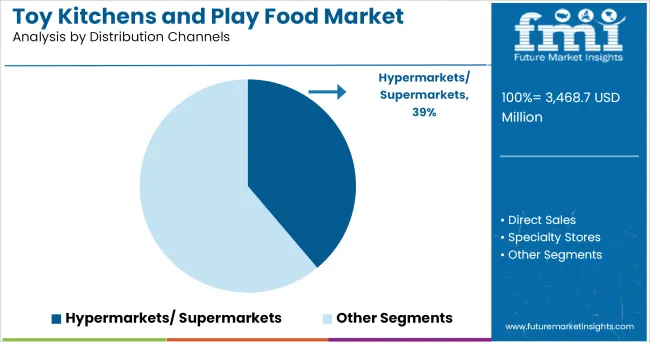
The Hypermarkets/Supermarkets segment is projected to account for 38.9% of the toy kitchens and play food market revenue in 2025, making it the leading distribution channel. Growth of this segment has been driven by the convenience and accessibility of purchasing toys alongside household essentials, especially during seasonal promotions.
Hypermarkets and supermarkets have effectively positioned toy sections near high traffic areas enhancing product visibility and enabling impulse buying behavior among parents and gift shoppers. Retail partnerships with major toy brands have facilitated exclusive product offerings and bundled deals, attracting consumers to these retail formats.
Furthermore, these stores have been a primary choice for last minute gift purchases, given their widespread geographic reach and extended operating hours. As organized retail expands in emerging markets and consumer habits continue to favor one stop shopping, the Hypermarkets/Supermarkets segment is expected to sustain its leadership, supported by consistent product availability and in store promotional campaigns.
Having enjoyment while learning in a play food and toy kitchen can help children to develop spark a passion for cooking food and valuable life skills. Demand for kitchen sets is more in the market because this set helps to develop imagination through play. Children can imagine as grown-ups in different settings. For instance, during this play children became chefs, waitresses, waiters, pizza makers, mummies, daddies and many things in between.
The global toy kitchens and play food market are driven by growing demand for a kitchen set among children, especially among girls. Furthermore, the increasing penetration of social media platforms where kids come to know about new toys in the market and rising user engagement attributing to the growth of the kitchen toy market.
Play food and toy kitchen have always been the most popular toy to ever exist. In past, this set only has a plastic oven, few cooking pots, fruits and vegetables. But nowadays, players launched such smart kitchen sets that have the full range of kitchens including utensils and other accessories. This attracts kids to buy toy kitchens and also, this set can be included in a gift list at a reasonable price.
Furthermore, the growing focus of kids on smartphones and tablets are a big concern for parents. Due to their extreme use of electronic gadgets, they are under stress every single day. So parents and guardians buy toys like kitchen sets and similar toys for their children that help them to manage their skills.
This kitchen set entertaining up to three to four children at a time. This allows children to follow their rule in the play kitchen, provide an opportunity to work together, for instance, if one child is putting everything away, another doing the cooking and another cleaning up. This is a perfect example of teamwork. Hence, within playing kitchen toy, children get teamwork skills that will remain with them in all stages of life.

In the USA, the demand for pre-school toys is higher owing to increased sales of mathematics, science, art, technology-based gadgets. On the other hand, some people of Canada prefers toys like a kitchen set, doctor kit etc. due to the belief that these toys will help children to gain more knowledge and intelligence, in turn, leading to augmented demand.
Furthermore, increasing birth index, along with rising income is supposed to be given a good market opportunity for toy kitchens and play food during the forecast period. The growing popularity of such toys among the children of the region opens the door for players to strengthen their presence in the regional market.
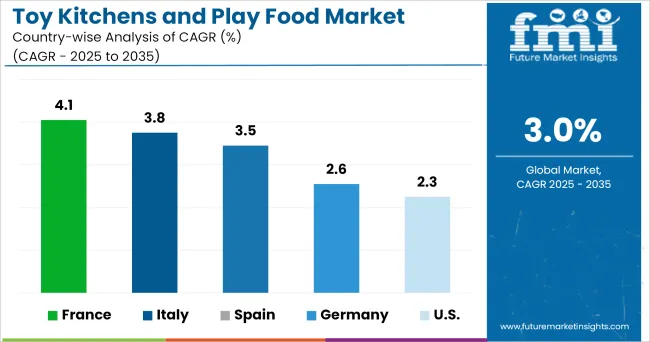
The market of toy kitchen and play food remains resistant and buoyant as the good spike in the overall sales during the lockdown period with the help of online supply channels.
Also, with the trend of work from home or study from home culture, and closing of tourism and leisure venues, people of Europe have planned to stimulate children to enjoy at home with different toys including kitchen set and bring joy, happiness to the house. And this plan brings good sales in the European countries.
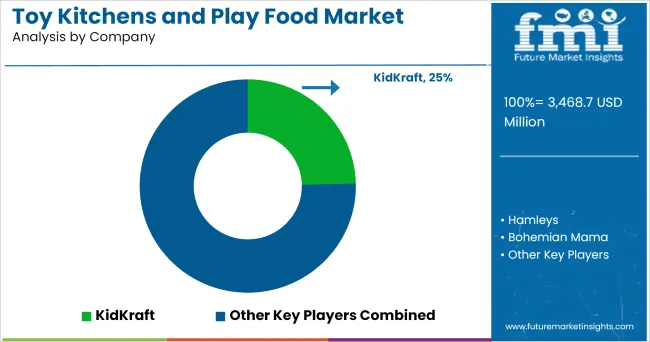
Some of the leading manufacturers of toy kitchens and play food market include
Some of the key players are working on research to design a kitchen toys as per the preference as well as comfort of the customers. Key players are planning to expand their business or sales by setting up of production plant or broadening their toys offering in the global market. Growing competition in the numerous regions is expected to augment the demand during the forecast period.
The report is a compilation of first-hand information, qualitative and quantitative assessment by industry analysts, inputs from industry experts and industry participants across the value chain. The report provides in-depth analysis of parent market trends, macro-economic indicators and governing factors along with market attractiveness as per segments. The report also maps the qualitative impact of various market factors on market segments and geographies.
The global toy kitchens and play food market is estimated to be valued at USD 3,468.7 million in 2025.
The market size for the toy kitchens and play food market is projected to reach USD 4,661.6 million by 2035.
The toy kitchens and play food market is expected to grow at a 3.0% CAGR between 2025 and 2035.
The key product types in toy kitchens and play food market are large play kitchens, corner play kitchen and toddler play kitchens.
In terms of distribution channels, hypermarkets/ supermarkets segment to command 38.9% share in the toy kitchens and play food market in 2025.






Full Research Suite comprises of:
Market outlook & trends analysis
Interviews & case studies
Strategic recommendations
Vendor profiles & capabilities analysis
5-year forecasts
8 regions and 60+ country-level data splits
Market segment data splits
12 months of continuous data updates
DELIVERED AS:
PDF EXCEL ONLINE
Toy Drones Market Size and Share Forecast Outlook 2025 to 2035
Toy Market Size and Share Forecast Outlook 2025 to 2035
Toy Storage Market Insights - Trends & Forecast 2025 to 2035
Toy Bag Market Analysis on Material Type, Bag Type, Category, Sales or Distribution Channel, and Region through 2025 to 2035
Toy Packaging Market Trends – Growth & Forecast 2024-2034
Pet Toys Market Analysis – Size, Share & Forecast 2025 to 2035
Cat Toys Market Analysis by Product Type, Material Type, Sales Channel, End-User, Application and Region Through 2035
Kids Toys Market Size and Share Forecast Outlook 2025 to 2035
Bath Toy Market Size and Share Forecast Outlook 2025 to 2035
Bird Toy Market Size and Share Forecast Outlook 2025 to 2035
IP Pop Toy Market Size and Share Forecast Outlook 2025 to 2035
Fabric Toys Market Size and Share Forecast Outlook 2025 to 2035
Outdoor Toys Market Size and Share Forecast Outlook 2025 to 2035
Male Sex Toys Market Forecast and Outlook 2025 to 2035
Smart/AI Toy Market Size and Share Forecast Outlook 2025 to 2035
Licensed Toy Market Size and Share Forecast Outlook 2025 to 2035
Die Cast Toys Market Size and Share Forecast Outlook 2025 to 2035
Connected Toys Market Size and Share Forecast Outlook 2025 to 2035
Educational Toys Market Analysis and Overview by Category, End-use Sector, and Area through 2035
Traditional Toys and Games Market Size and Share Forecast Outlook 2025 to 2035

Thank you!
You will receive an email from our Business Development Manager. Please be sure to check your SPAM/JUNK folder too.
Chat With
MaRIA